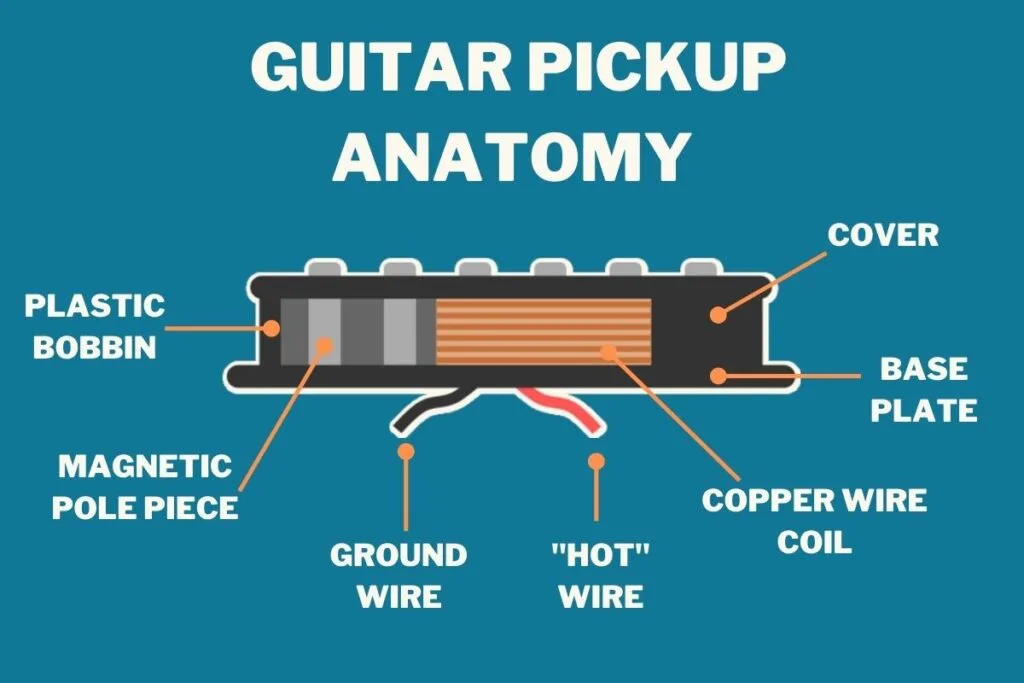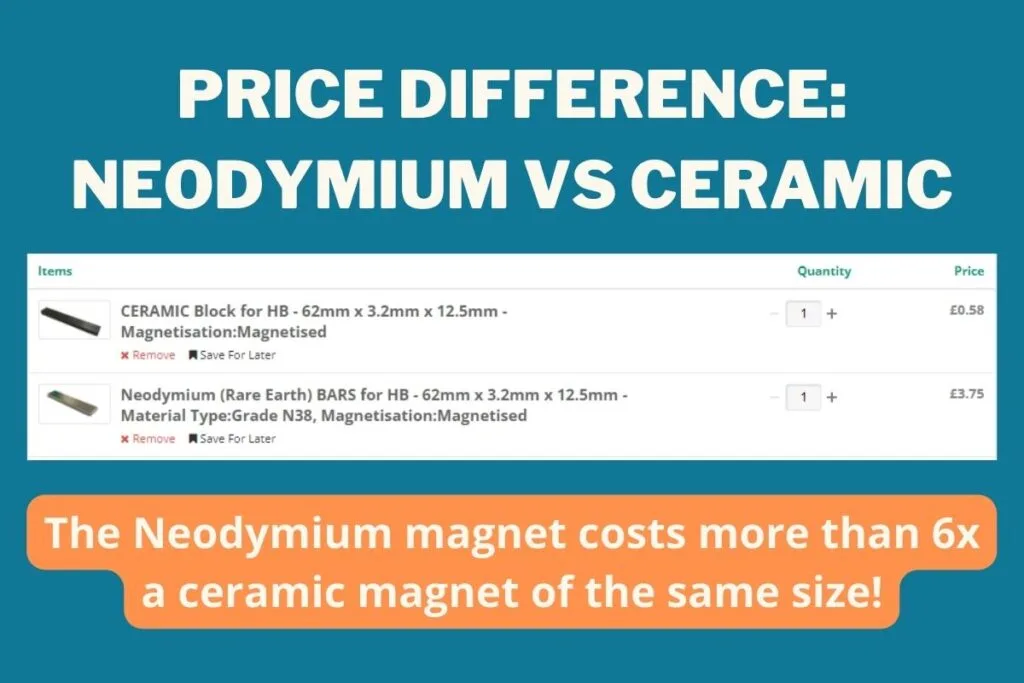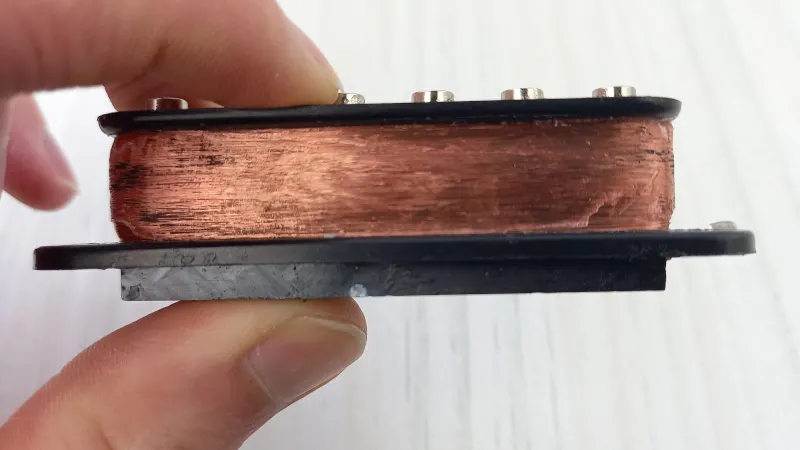As a guitarist, you probably know that your pickups play an important role in shaping the sound and tone of your guitar. But, have you ever wondered how guitar pickups work?
Before I really understood them, my answer to that question would have been “something to do with magnets”. Close, past me, but not close enough.
Here’s how they actually work:
Guitar pickups work by transforming vibrations from guitar strings into an electric signal. The magnets in the pickup magnetize the guitar strings, which vibrate towards and away from a copper wire coil in the pickup when strummed. This movement produces a signal by electromagnetic induction. The signal is then sent from the pickup to the guitar’s output jack.
Interesting, right? But now you’re probably wondering how this actually happens (and what’s “electromagnetic induction”?!). Well, don’t worry!
I’ve written this simple guide to explain not only how pickups work but also why they work. I’ve covered:
- the different parts of a pickup
- how these parts affect the tone
- how they work together to make a sound
By getting a better understanding of how pickups work on your guitar, you’ll be that one step closer to getting a legendary guitar tone that works for you, every time.
What is a guitar pickup?
So, let’s start at the beginning: what is a guitar pickup?
Well, a guitar pickup is the thing that sits underneath your guitar strings. Its job is to turn the vibration of your guitar string into an electric signal that’s passed to your output jack, and onwards to your amp or DAW.

Your guitar’s pickups are the key factor to your guitar’s tone and how it sounds when coming out of an amp (aside from the amp itself!).
Different guitar models use different amounts and types of pickups depending on their design and intended use.
For example, a guitar that is used more for country music will likely have single coil pickups installed, for a clean and jangly tone. A guitar used for hard rock, on the other hand, will probably use humbuckers for a thicker, more driving tone.
Not only that, but there’s also a lot of variation in how guitar pickups of the same type sound, due to how they’re made and the material they’re made from.
Guitar pickup anatomy
Most pickups follow the same design: they’re made out of a plastic bobbin, magnetic pole pieces (or metal pole pieces and a magnet – yes, there’s a difference!), a coil of very thin copper wire, output wires, a base plate, and a cover.
Let’s look at how this all comes together to form a pickup.

Plastic bobbin
The bobbin forms the core of the pickup and provides a solid structure that can hold the pole pieces and wire in place. It’s made of plastic, which isn’t a conductive material, so it doesn’t interfere with any of the electronics.
The shape of the bobbin can play an important role in the overall sound of the pickup, as it affects the amount of copper wire that can be wrapped around it (which we’ll get to shortly…).
Pole pieces and magnets
The pole pieces are the magnetic parts of a pickup. Their job is to magnetize the guitar strings above them.
The metal pole pieces are inserted into the plastic bobbin at an equal distance. Most pickups are designed with 6 pole pieces that are spaced evenly apart to sit under each string. This ensures that they magnetize each string equally.
Sometimes you’ll see the metal bits of the pickup called “magnets” and other times “pole pieces”, so what’s the difference?
Well, the terms are used interchangeably, but it is worth pointing out that not all pole pieces are inherently magnetic.
Some pickups use magnetic pole pieces, meaning that the actual pole pieces are always magnetic. If you took one out of the pickup, it would act as a magnet that you could stick to your fridge (if you wanted to).
Other pickups use ordinary metal as the pole piece which are just regular pieces of metal shaped like pole pieces that aren’t inherently magnetic.
Instead, there’s a magnetic bar that sits underneath the pickup that magnetizes the metal pole pieces. So, if you were to move these pole pieces away from the magnet, they’d no longer be magnetic!

It’s a very small difference, but one that can have a slight effect on the overall tone of the pickup. Generally speaking (very generally, as there’s a lot of factor that can affect the sound!) magnetic pole pieces tend to send a bit brighter than their non-magnetic counterparts.
Magnet types
Here’s where I think pickups start to get fun: the magnet types.
The type of magnet that’s used in a guitar pickup has a large effect on its overall sound and tone. This is caused by the different strengths of “magnetic pull” from magnets, which is measured in “Gauss” units.
You may now be wondering why pickup magnets have different levels of pull. Without getting too sciency about it: it’s because different magnets can only get so magnetic.
When the magnets are made, they’re start as just ordinary pieces of metal that are put under really strong electromagnets.
The long exposure to the electromagnet turns the ordinary piece of metal into a permanent magnet.
The different types of metal have different “saturation points” which is the limit of how magnetic they can get. So, some magnets become more magnetic than others, which affects the final signal made!
For this reason, a lot of guitarists have a preference on the type of magnet used in their pickups.
There’s 3 main types of magnets used in guitar pickups: Alnico, Ceramic, and Neodymium.
Alnico
Alnico magnets are made from a mixture of aluminium (Al), nickel (Ni), and cobalt (Co), hence the name Alnico!
They’re arguably the most versatile magnet used for guitar pickups, and a common favorite amongst many guitarists.
There’s a few different blends of Alnico that produce magnets with different amounts of magnetic pull. The types most commonly used in electric guitar pickups are Alnico 2 (II), Alnico 3 (III), and Alnico 5 (V).
- Alnico II: This blend of Alnico produces a smoother, warmer tone compared to other magnets and is commonly found in pickups looking to replicate a “vintage” tone.
- Alnico III: Alnico III is the weakest of these 3 types and also the least commonly used Alnico blend. You’ll usually find this magnet in neck pickups, where the string vibration is strongest.
- Alnico V: Finally, Alnico V has a stronger output than the other Alnico magnets due to it’s stronger magnetic pull. They have a bright and punchy tone that will cut through any mix.
Ceramic
Ceramic magnets, also called “ferrite”, are made from mostly iron and small amounts of other metallic materials.
They’re a strong magnet which means that they result in a high output. They’re also cheap.
Just look at the price comparison between these two similar magnets. The Alnico versions costs over 3x the price of their ceramic equivalents.

The low cost makes them the first choice for guitar manufacturers looking to make a cheap model. As you can imagine, cheaply made guitar pickups often don’t sound too good.
The combination of the high output magnet, and often a highly wound wire coil, means that the cheaper pickups often sound thin, brittle, and harsh.
Because of this, ceramic magnets often get a bad reputation in the guitarist community. People associate them with being cheap and often disregard them.
But, a lot of premium guitar pickups use ceramic magnets for their ability to create a high-output signal. With the proper care and wiring, a ceramic magnet can sound bright, crunchy, and clear.
Take a look at Lace Sensor pickups, for example, which are ceramic pickups that are used by a lot of famous guitarists.
Contrary to popular opinion, I actually prefer the sound of the ceramic pickups on my Fender Mexican Standard Stratocaster than the Alnico V pickups on my American Standard Strat.
I find that they’re bright and clear, compared to the Alnico’s which can by a bit too dry and punchy for me.
Check out this sound comparison between my ceramic and Alnico V bridge pickups and see which ones you prefer.
Here’s the ceramic pickup:
Here’s the Alnico pickup:
Neodymium
Last on the list is neodymium, which is both the strongest and least common type of magnet used for pickups.
In fact, they’re more common on bass guitars than on electric guitars. This is because the magnet is so strong that it can actually pull the lighter guitar strings towards it, which affects the sound.
In addition to this, their lack of mainstream presence is mostly down to their cost and value.
Because of their strong magnetic pull, they’re very comparable to ceramic magnets. But, take a look at the below example. A neodymium magnet costs up to 6x the price of a ceramic one.

So, if you can get a similar sound for a fraction of the price, then why bother? That’s the approach taken by most mainstream manufacturers.
You’ll see neodymium pickups mostly from niche pickup makers and online experimentalists!
Copper wire coil
The next step of pickup construction is to wrap copper wire around the bobbin to form a copper coil.
The wire used for pickups is incredibly thin. In fact, it’s about as thin as a strand of hair! This means that it can be wound thousands of times around the bobbin to form a coil capable of inducing an electrical signal.

Generally speaking, more winds means a stronger (or “hotter”) signal, but too many winds can make the signal distorted. Pickups can range from having around 7 thousand winds, for a lower output “cleaner” signal, to 10 thousand winds, for a hotter signal.
This is where bobbin shape comes into play. The different shapes and sizes will mean different amounts of wire is used for winding, which can affect the final tone!
Once the pickup is wound, each end of the copper wire is connected to a lead wire. One wire carries the signal, and the other is the ground wire.
From here, the pickup may be covered in a wax or lacquer to protect the wire and stop it from moving. This is called “potting”. After this, the wire can be covered with insulation tape to further protect it from damage.
Base plate and cover
Now that the pickup is wound, the base of the bobbin is attached to a base plate that has screw holes. A pickup cover is then put on top to protect the inner workings of the pickup from any dust, grime, or damage.
The cover has matching screw holes that allow the finished pickup to be mounted to the guitar by being screwed into either a pickguard or pickup ring.
So, now that you know how a pickup is made, I’ll explain how it works, and how most people are getting this wrong.
How a guitar pickup works
Now that you know what they’re made from, let’s look at how all these pieces come together to make the pickup work.
Guitar pickups work by generating an electrical signal from a magnetized string vibrating towards and away from a copper coil of wire. This vibration creates and electric signal through “electromagnetic induction”. The signal is then sent to the guitar’s output jack.
If this all sounds too much like physics 101, don’t worry! I’ll explain how it works in a way that’s straightforward to understand, starting with electromagnetic induction.
Electromagnetic induction
While it may sound complicated, electromagnetic induction is actually pretty simple to understand!
It was first observed by Michael Faraday, an English physicist, in 1831. He noticed that moving a magnet through a coil of wire, without either touching, generated an electric current.
The more coils there were on the wire, the stronger the electric current was.
So, how does this relate to guitar pickups? Well, in this case the guitar strings are the magnet (remember, they’re being magnetized from below) and the copper wire coil is… well, the wire coil!
When the strings vibrate, their magnetic field moves in and out of the copper coil beneath, exactly like Faraday’s early experiment.
The signal that’s generated is carried by the output wire to the output jack.
That’s as technical as I’ll get about the physics of it. If you are interested in the super-sciency stuff, I recommend checking out this interactive article about induction.
Passive vs Active pickups
So far, I’ve only talked about what’s known as “passive pickups”, which are pickups that work without any external power. There is another type of pickup, however, called “active pickups”.
Active pickups are designed in exactly the same way as a passive pickup, and essentially work the same too, but with a few key differences.
Firstly, they tend to have much fewer winds on the copper coil, which results in a much weaker, but much cleaner, signal.
To help boost this weaker signal, active pickups have an internal preamp circuit (typically powered by a 9v battery) to make the signal louder. This results in a loud signal that’s cleaner than a passive pickup.
This makes it a great choice for guitarists who like to crank their guitar up and pump it with distortion, typically hard rock and metal.
Pickup distance
The distance of a pickup from a string makes a big difference to the sound as well. A pickup that’s closer to a string will produce a louder signal than those that are further away.
As a general rule, I press my string down at the last fret and set my pickups to a height of 1/8th of an inch away from the string. From here, I play the guitar clean through headphones and adjust to find the best position that works for me!
Weaker magnets, such as Alnico, may need to sit closer to the string than ceramic magnets for the optimum sound.
Busting the pickup myth
Now that you know how pickups work, let’s take a look at (and debunk) a common myth.
Look online for an explanation on how guitar pickups work and you’ll find countless articles talking about how the vibration of the guitar string interrupts the magnets magnetic field which somehow creates a signal.
While this sounds like something that could be true, it isn’t.
As we now know, it’s the strings that are magnetized, and their magnetic field creates a signal in the copper wire through inductance.
In fact, there’s a really simple experiment that demonstrates this is true.
In this YouTube video, 2 pickups are placed on a guitar: one above and one below the strings. The one below is a complete pickup, but the one above has had the magnetic pole pieces removed, leaving only the copper coil.
The experimenter then plays the guitar strings, and both pickups can produce a signal.
Why? Because the strings are still magnetized from the pickup under the strings. This proves that the pickup is only generating the signal from the movement of magnetized strings towards and away from a copper coil.
In fact, this phenomenon was known by the creator of Gibson’s “PAF” pickups, Seth Lover, who said:
“… the magnetic field comes up to the stings there and magnetizes the strings. That’s one of the things that most people don’t understand. They figure that string is waving there and cutting the magnetic lines of force. Nuts. That isn’t it. The magnet, all it does is magnetize the string. Now you’ve got a waving magnetic field. And we have a fixed coil with a waving magnetic field to induce voltage. If you want to, take the magnet out. One you’ve magnetized your strings, it will play until the string loses it”
Going further, if we were to remove every magnet from the guitar and find a way to magnetize the strings (like by running a current through the strings) the pickups would still work!
That being said, playing strings with a current running through them would be very uncomfortable! So, having magnets under the strings is a very convenient way to magnetize them.
Related Questions
What makes guitar pickups sound different?
The primary reasons that guitar pickups sound different are the magnet type used and the amount of times the wire coil is wound. Stronger magnets like Ceramic and Alnico V will create a stronger signal, and weaker magnets like Alnico II will create a weaker signal. Likewise, a wire with more coils will create a stronger output than a pickup with fewer coils. Other factors can include the shape of the pickups, their height, whether they’re active or passive, and the pickup design (e.g. single coil or humbucker).
Why do pickups hum?
The humming noise in a pickup is caused by the copper coil picking up electromagnetic frequencies. These background frequencies come from electrical equipment such as a mobile phone, lighting, your computer, amplifier, and powerlines. Humming tends to be more noticeable in single coil pickups. Humbuckers are designed to minimize the amount of hum that’s sent to the amplifier.

Conor is a music producer, multi-instrumentalist, and all-round enthusiast from the UK with over 15 years of experience. He’s the founder and sole-content creator for the roundtable audio blog and YouTube channel.
